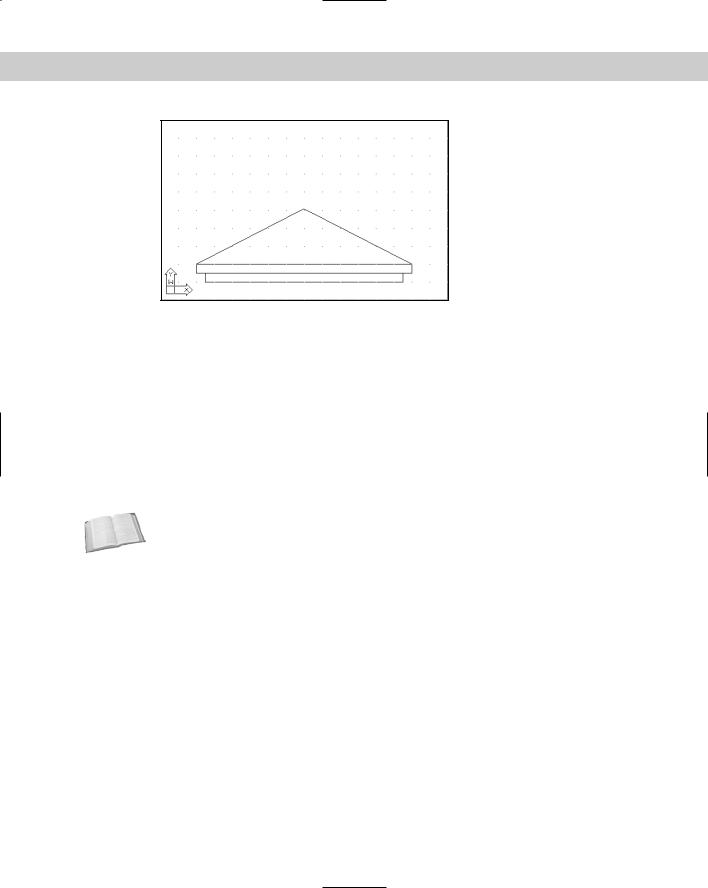
- •Foreword
- •Preface
- •Is This Book for You?
- •How This Book Is Organized
- •How to Use This Book
- •Doing the Exercises
- •Conventions Used in This Book
- •What the Icons Mean
- •About the CD-ROM
- •Other Information
- •Contacting the Author
- •Acknowledgments
- •Contents at a Glance
- •Contents
- •Getting Acquainted with AutoCAD and AutoCAD LT
- •Starting AutoCAD and AutoCAD LT
- •Creating a New Drawing
- •Using the AutoCAD and AutoCAD LT Interface
- •Creating Your First Drawing
- •Saving a Drawing
- •Summary
- •Creating a New Drawing from a Template
- •Working with Templates
- •Opening a Drawing with Default Settings
- •Opening an Existing Drawing
- •Using an Existing Drawing as a Prototype
- •Saving a Drawing Under a New Name
- •Summary
- •The Command Line
- •Command Techniques
- •Of Mice and Pucks
- •Getting Help
- •Summary
- •Typing Coordinates
- •Displaying Coordinates
- •Picking Coordinates on the Screen
- •Locating Points
- •Summary
- •Unit Types
- •Drawing Limits
- •Understanding Scales
- •Inserting a Title Block
- •Common Setup Options
- •The MVSETUP Command
- •Summary
- •Using the LINE Command
- •Drawing Rectangles
- •Drawing Polygons
- •Creating Construction Lines
- •Creating Rays
- •Summary
- •Drawing Circles
- •Drawing Arcs
- •Creating Ellipses and Elliptical Arcs
- •Making Donuts
- •Placing Points
- •Summary
- •Panning
- •The ZOOM Command
- •Aerial View
- •Named Views
- •Tiled Viewports
- •Snap Rotation
- •User Coordinate Systems
- •Isometric Drawing
- •Summary
- •Editing a Drawing
- •Selecting Objects
- •Summary
- •Copying and Moving Objects
- •Using Construction Commands
- •Creating a Revision Cloud
- •Hiding Objects with a Wipeout
- •Double-Clicking to Edit Objects
- •Grips
- •Editing with the Properties Palette
- •Selection Filters
- •Groups
- •Summary
- •Working with Layers
- •Changing Object Color, Linetype, and Lineweight
- •Working with Linetype Scales
- •Importing Layers and Linetypes from Other Drawings
- •Matching Properties
- •Summary
- •Drawing-Level Information
- •Object-Level Information
- •Measurement Commands
- •AutoCAD’s Calculator
- •Summary
- •Creating Single-Line Text
- •Understanding Text Styles
- •Creating Multiline Text
- •Creating Tables
- •Inserting Fields
- •Managing Text
- •Finding Text in Your Drawing
- •Checking Your Spelling
- •Summary
- •Working with Dimensions
- •Drawing Linear Dimensions
- •Drawing Aligned Dimensions
- •Creating Baseline and Continued Dimensions
- •Dimensioning Arcs and Circles
- •Dimensioning Angles
- •Creating Ordinate Dimensions
- •Drawing Leaders
- •Using Quick Dimension
- •Editing Dimensions
- •Summary
- •Understanding Dimension Styles
- •Defining a New Dimension Style
- •Changing Dimension Styles
- •Creating Geometric Tolerances
- •Summary
- •Creating and Editing Polylines
- •Drawing and Editing Splines
- •Creating Regions
- •Creating Boundaries
- •Creating Hatches
- •Creating and Editing Multilines
- •Creating Dlines
- •Using the SKETCH Command
- •Digitizing Drawings with the TABLET Command
- •Summary
- •Preparing a Drawing for Plotting or Printing
- •Creating a Layout in Paper Space
- •Working with Plot Styles
- •Plotting a Drawing
- •Summary
- •Combining Objects into Blocks
- •Inserting Blocks and Files into Drawings
- •Managing Blocks
- •Using Windows Features
- •Working with Attributes
- •Summary
- •Understanding External References
- •Editing an Xref within Your Drawing
- •Controlling Xref Display
- •Managing Xrefs
- •Summary
- •Preparing for Database Connectivity
- •Connecting to Your Database
- •Linking Data to Drawing Objects
- •Creating Labels
- •Querying with the Query Editor
- •Working with Query Files
- •Summary
- •Working with 3D Coordinates
- •Using Elevation and Thickness
- •Working with the User Coordinate System
- •Summary
- •Working with the Standard Viewpoints
- •Using DDVPOINT
- •Working with the Tripod and Compass
- •Getting a Quick Plan View
- •Shading Your Drawing
- •Using 3D Orbit
- •Using Tiled Viewports
- •Defining a Perspective View
- •Laying Out 3D Drawings
- •Summary
- •Drawing Surfaces with 3DFACE
- •Drawing Surfaces with PFACE
- •Creating Polygon Meshes with 3DMESH
- •Drawing Standard 3D Shapes
- •Drawing a Revolved Surface
- •Drawing an Extruded Surface
- •Drawing Ruled Surfaces
- •Drawing Edge Surfaces
- •Summary
- •Drawing Standard Shapes
- •Creating Extruded Solids
- •Drawing Revolved Solids
- •Creating Complex Solids
- •Sectioning and Slicing Solids
- •Using Editing Commands in 3D
- •Editing Solids
- •Listing Solid Properties
- •Summary
- •Understanding Rendering
- •Creating Lights
- •Creating Scenes
- •Working with Materials
- •Using Backgrounds
- •Doing the Final Render
- •Summary
- •Accessing Drawing Components with the DesignCenter
- •Accessing Drawing Content with Tool Palettes
- •Setting Standards for Drawings
- •Organizing Your Drawings
- •Working with Sheet Sets
- •Maintaining Security
- •Keeping Track of Referenced Files
- •Handling Errors and Crashes
- •Managing Drawings from Prior Releases
- •Summary
- •Importing and Exporting Other File Formats
- •Working with Raster Images
- •Pasting, Linking, and Embedding Objects
- •Summary
- •Sending Drawings
- •Opening Drawings from the Web
- •Creating Object Hyperlinks
- •Publishing Drawings
- •Summary
- •Working with Customizable Files
- •Creating Keyboard Shortcuts for Commands
- •Customizing Toolbars
- •Customizing Tool Palettes
- •Summary
- •Creating Macros with Script Files
- •Creating Slide Shows
- •Creating Slide Libraries
- •Summary
- •Creating Linetypes
- •Creating Hatch Patterns
- •Summary
- •Creating Shapes
- •Creating Fonts
- •Summary
- •Working with Menu Files
- •Customizing a Menu
- •Summary
- •Introducing Visual LISP
- •Getting Help in Visual LISP
- •Working with AutoLISP Expressions
- •Using AutoLISP on the Command Line
- •Creating AutoLISP Files
- •Summary
- •Creating Variables
- •Working with AutoCAD Commands
- •Working with Lists
- •Setting Conditions
- •Managing Drawing Objects
- •Getting Input from the User
- •Putting on the Finishing Touches
- •Summary
- •Understanding Local and Global Variables
- •Working with Visual LISP ActiveX Functions
- •Debugging Code
- •Summary
- •Starting to Work with VBA
- •Writing VBA Code
- •Getting User Input
- •Creating Dialog Boxes
- •Modifying Objects
- •Debugging and Trapping Errors
- •Moving to Advanced Programming
- •A Final Word
- •Installing AutoCAD and AutoCAD LT
- •Configuring AutoCAD
- •Starting AutoCAD Your Way
- •Configuring a Plotter
- •System Requirements
- •Using the CD with Microsoft Windows
- •What’s on the CD
- •Troubleshooting
- •Index

90 |
Part I AutoCAD and AutoCAD LT Basics |
sizes. The conventions used in your discipline or working environment also affect your decision. You may be working on a series of drawings that are all to be plotted on the same size sheet of paper.
As an example, the architectural drawing in Figure 5-3 is 175-feet wide by 120-feet high. The two most typical scales for a drawing of a house are 1⁄4"=1' and 1⁄8"=1'. On a small plotter, you might have a choice of sheet sizes A, B, or C. The following steps show the calculations you need to do in order to decide on a scale, obtain the scale factor, and determine the appropriate sheet size.
In this exercise, you practice determining the scale and sheet size. You need only a sheet of paper and a pencil. Use Figure 5-3 as a reference.
STEP-BY-STEP: Determining the Scale and Sheet Size
1.To calculate the plotted size of the drawing at 1⁄4"=1', you can start with the width, which is 175'. Take one-quarter of 175 to get the width of the drawing in inches, which is 433⁄4".
2.Take one-quarter of the height, 120', to get the height of the drawing in inches, which is 30".
3.A size-C sheet (see Table 5-3) is 22"×17", which is too small for a 433⁄4"×30" drawing.
4.Recalculate the drawing at 1⁄8"=1'. Take one-eighth of 175 to get 217⁄8. Take one-eighth of 120 to get 15".
5.The actual drawing space (minus the margins the printer requires) on a size-C sheet is about 21"×16". The height of the drawing at this scale is adequate, but the width is 7⁄8" too long. Therefore, the best bet is to simply make the drawing 7⁄8" narrower because the drawing has some extra room. This lets you fit the drawing on a size-C sheet.
6.To calculate the scale factor of a 1⁄8"=1' scale, multiply 1' by 8 to get 8' and convert it to inches, which is 96 (8×12).
Rearranging the views, dimensions, and text on a drawing to fit a standard scale factor and sheet size is a typical task. There is no actual setup step for setting the drawing scale, but you use it when you insert text or dimensions and when you plot the drawing.
Inserting a Title Block
A title block is a rectangle that includes spaces for the drawing title, company name, drafter name, and so on. It generally comes with a border that bounds your drawing. Many drawings require title blocks. You can insert an existing title block in two ways:
When creating a new drawing, choose File New to open the Select Template dialog box. Choose one of the templates that includes a title block. For example, ANSI
A –Named Plot Styles.dwt includes a title block and border that fit on an A-size sheet. The title block and border appear on a layout tab. (Chapter 17 covers layouts.)
After you open a drawing, you can insert a drawing of a title block into it. Choose Insert Block. (Chapter 18 covers blocks.) In the Insert dialog box, type the name of the drawing or block or click Browse to find it. Most of the templates have a corresponding drawing that you can insert. You can find them in the \Template folder. To insert the file or block at 0,0 with no scaling or rotation, uncheck all the Specify On-Screen check boxes. Check Explode if you expect to edit the inserted title block after it’s in your drawing. Click OK.

Chapter 5 Setting Up a Drawing |
91 |
New |
To find the location of the templates and their corresponding drawings, choose Tools |
Feature |
Options and click the Files tab. Double-click Drawing Template Settings and then double- |
|
|
|
click Drawing Template File Location. You see the path to the location displayed. (The path is |
|
very long!) This folder may be hidden in Windows Explorer. For instructions on displaying |
|
hidden folders, go to Windows Help and enter hidden folders in the search box. |
Cross- |
As explained in Chapter 2, you can create your own title block, make a template from it, and |
Reference |
then start a drawing based on that template. |
|
Common Setup Options
A few other items are generally set up in advance and are included in a template. Other chapters of this book cover the following:
Layers (covered in Chapter 11) enable you to organize your drawing into meaningful groups. In an architectural drawing, for example, you might create a layer for walls, another for doors, one for electrical fixtures, and so on.
Text styles (covered in Chapter 13) enable you to format the font and other text characteristics.
Dimension styles (covered in Chapter 15) format the dimensions that measure your objects.
System Variables
When you change settings in AutoCAD or AutoCAD LT, such as the unit type, angle type, drawing limits, blip marks, snap mode (on or off), grid mode, or ortho mode, you’re actually changing system variables. These are simply settings that are stored in each drawing or in the Windows registry (which stores settings that apply to all drawings). Usually, you don’t need to pay any direct attention to them, but they’re the nuts and bolts behind the dialog boxes you use to change the settings. When you start customizing AutoCAD, you need to learn about them because programming code and script files (macros) cannot access dialog boxes. Also, a few system variables are accessible only by typing them directly on the command line. Bonus Chapter 1 on the CD provides more information on system variables. Throughout this book, I occasionally mention system variables when using them directly is useful. Some system variables store information about a drawing or the drawing environment, such as the drawing name and path. These are read-only, meaning that you cannot change them. They exist to provide information and are often used in AutoLISP programs. (AutoLISP works in AutoCAD only.)
Information about each system variable, where it is stored, its default, and whether it is read-only is in the Help system. Choose Help Help and double-click Command Reference on the Contents tab. Then double-click System Variables. You can type system variables on the command line, just like regular commands. The Express Tools (AutoCAD only) contain an editor (choose Express Tools System Variable Editor) that enables you to edit system variable values in a dialog box; it also provides helpful supporting information.

92 |
Part I AutoCAD and AutoCAD LT Basics |
If you know you’ll be using snap, grid, and ortho a lot in certain drawings, and you know the suitable settings for snap and grid, you can set these and save them in a template because these settings are saved with the drawing. In other cases, you might want to leave them off and turn them on only when you need them.
Many settings, such as running object snaps, the type of snap (grid or polar), and the polar distance when you’re using PolarSnap are saved in the Windows registry, not in your drawing. As a result, when you open AutoCAD or AutoCAD LT, they’re automatically set to the same setting you had when you last closed the program, regardless of the setting in the drawing. Therefore, you cannot save these settings in a template.
In this exercise, you practice specifying the drafting settings and creating a template.
On the |
The drawing used in the following Step-by-Step exercise on setting drawing aids and creat- |
CD-ROM |
ing a template, ab05-02.dwg, is in the Results folder on the CD-ROM. |
STEP-BY-STEP: Setting Drawing Aids and Creating a Template
1.If you did the exercise on drawing limits, use that drawing or open ab05-02.dwg from the Results folder of the CD-ROM.
2.Save the drawing as ab05-03.dwg in your AutoCAD Bible folder.
3.Choose Tools Drafting Settings.
4.On the Snap and Grid tab, the snap spacing is set to 1⁄2". In the Grid section, change the X spacing to 1". Make sure the Snap Type is set to Grid Snap and Rectangular Snap. Click OK.
5.Click SNAP and GRID on the status bar to turn them on. Make sure OSNAP is turned off.
6.Choose Format Units. Change the Angle Type back to decimal degrees. Click OK.
7.Using the coordinate display as your guide, start the LINE command and draw line segments from 21⁄2, 11⁄2 to 1⁄2<270 to 11"<0 to 1⁄2<90. End the LINE command.
8.Start the LINE command again. Again use the coordinate display to draw line segments from 2,2 to 1⁄2<270 to 1'0"<0 to 1⁄2<90. End the LINE command.
9.Save your drawing. It should look like Figure 5-4. Notice how the grid and snap settings facilitate the drawing process.
The architectural units create a different drawing experience than decimal units would. Setting up a drawing creates a drawing environment suited to your work needs.
10.Choose File Save As. In the Save Drawing As dialog box, click the Files of Type dropdown list box and choose AutoCAD Drawing Template or AutoCAD LT Drawing Template (*.dwt). Notice that you’re automatically in the \Template folder.
11.In the File Name text box, change the name to archroof.dwt. Click Save.
12.In the Template Description dialog box, type Arch units, 16,10 limits, snap & grid and click OK.

Chapter 5 Setting Up a Drawing |
93 |
Figure 5-4: The final architectural drawing.
13.Choose File New. Choose the archroof template and click Open. A new drawing opens, using the template.
14.Move the cursor around and look at the coordinate display to confirm that the grid is set is set to 1" although the snap is set to 1⁄2".
Do not save this new drawing.
The MVSETUP Command
The MVSETUP command is used in two different ways: to set up a drawing and to create viewports for paper space layouts. This command does not exist in AutoCAD LT.
Cross- |
Paper space layouts are a way of laying out your drawing in preparation for printing or plot- |
Reference |
ting. Chapter 17, which covers laying out a drawing as well as plotting, discusses paper space |
|
|
|
layouts. |
MVSETUP provides a command-line routine to walk you through some of the basic setup functions discussed in this chapter. You can use MVSETUP when you start to customize AutoCAD to set up a drawing from a script file or AutoLISP program (topics covered in Parts VI and VII of this book). To use MVSETUP, type mvsetup on the command line. AutoCAD responds with the following prompt:
Enable paper space? [No/Yes] <Y>:
Type n to use MVSETUP without entering paper space.
The next prompt lets you enter the units type:
Enter units type [Scientific/Decimal/Engineering/Architectural/Metric]:
Choose the option you want. Then AutoCAD displays a list of scale factors appropriate to the units option you chose. At the Enter the scale factor: prompt, type in a numeric scale factor.
